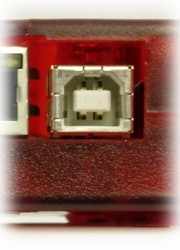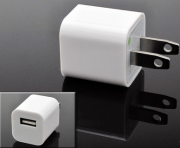5.0 USB [T-Series Datasheet]
Connector Type: USB-B Receptacle
Compatible: USB 1.1+
Max Cable Length: 5 meters
Max Packet Size: 64 bytes/packet
The USB connection can supply power, communication, or both.

LabJack USB Type-B connector
When USB is used for power, the 5V supply from the USB cable will be used to power the T-Series device. The cable can transfer power from a host computer's USB system or from a 5V wall adapter. Section 9 contains additional information about power supply options.
T-Series devices that are powered through the USB connection can communicate via USB, Ethernet or WiFi (if available).
USB Speeds
USB speeds and other specifications are summarized on Wikipedia, and described in complete detail on the USB website.
The T4 and T7 are "Full-Speed" USB 2.0 devices and will always establish a "Full-Speed" connection.
The T8 is a "High-Speed" USB 2.0 device. It will establish a "High-Speed" connection when connected to a USB 2.0 (or higher) system, or "Full-Speed" connection when connected to a USB 1.1 system.
"But I Don't Know How To Speak USB?"
Don't worry ... the LJM Library takes care of the USB details. Just call the Open functions to get a handle to a particular device (e.g. HandleA), and then make simple calls such as eReadName(HandleA, "AIN0") which returns the voltage from analog input 0. We have examples for many development environments and even some simple ready-to-run software.
Power Considerations
USB ground is connected to the T-series device's ground (GND), since standard USB is non-isolated. USB ground is generally the same as the ground of the PC chassis and AC mains.

If electrical isolation between the T-series device and host is desired, use Ethernet (or WiFi) instead, or add a USB isolator.
Any host port or self-powered hub port should provide 4.75 - 5.25 volts at any current up to 500 mA, per USB specifications. This is sufficient to power a T4 or T7. When using a T8, a USB hub with a 2.5 to 3 A power supply is recommended. Note that some hubs are not up to USB specification, and at higher currents the supplied voltage drops below 4.75 volts.. Appendix A-5 provides additional information about device power supply requirements.
Designing a Custom Driver
We strongly recommend using our LJM library rather than creating a custom USB driver. LJM provides convenient device discovery, high-level functions, and programming flexibility.
A custom USB host interface will need to implement the basic operations of USB: find, open, write, read, and close. For read and write operations, packets should be formatted as Modbus TCP frames.
The USB interface on T-Series devices consists of the normal bidirectional control endpoint (0 OUT & IN), 3 used bulk endpoints (1 OUT, 2 IN, 3 IN), and 1 dummy endpoint (3 OUT).
Endpoint 1 - OUT, address 0x01.
Endpoint 2 - IN, address 0x82
Endpoint 3 - OUT address = 0x03, IN address = 0x83. Endpoint 3 OUT is not supported, and should never be used.
The size of the endpoints can vary. The T4 and T7 will always use 64-byte endpoints. The T8 will set its endpoints to 512 bytes when operating in high-speed mode, and 64 bytes when operating in low-speed mode.
All commands should be sent on Endpoint 1. The responses to commands will always be returned on Endpoint 2. Endpoint 3 is only used to send stream data from the T-Series device to the host.
The LabJack vendor ID is 0x0CD5.
T4 product ID is 0x0004.
T7 product ID is 0x0007.
T8 product ID is 0x0008;
Troubleshooting
If USB communication is not working, see USB Communication Failure.
